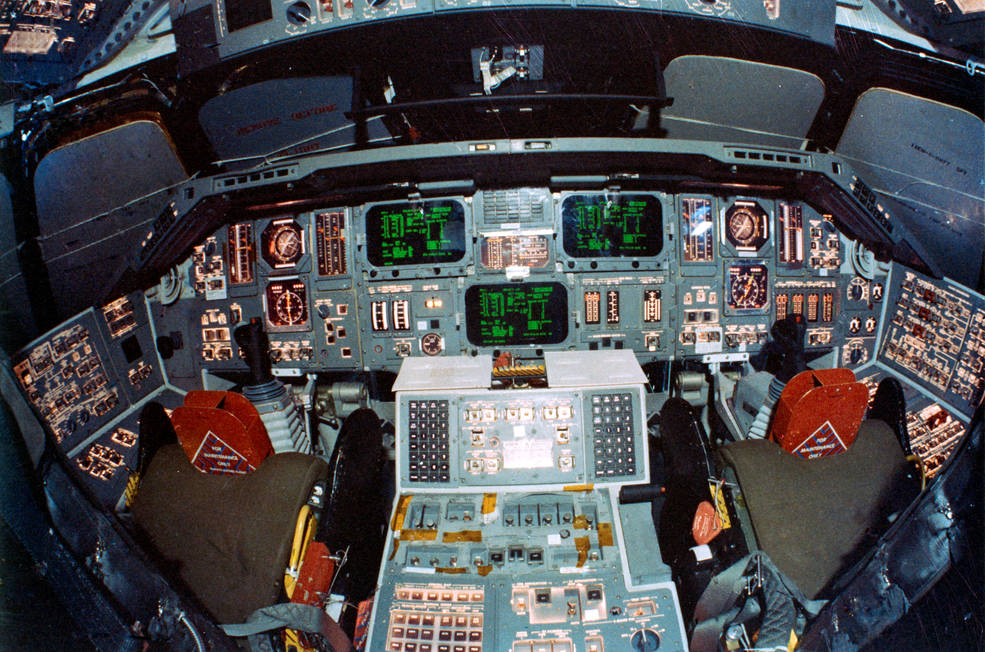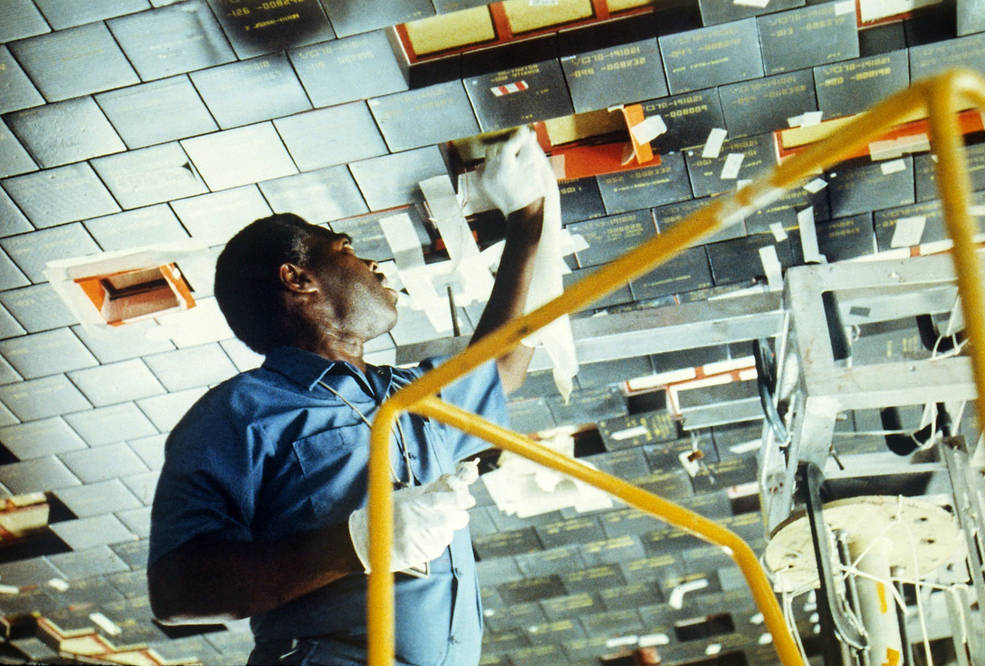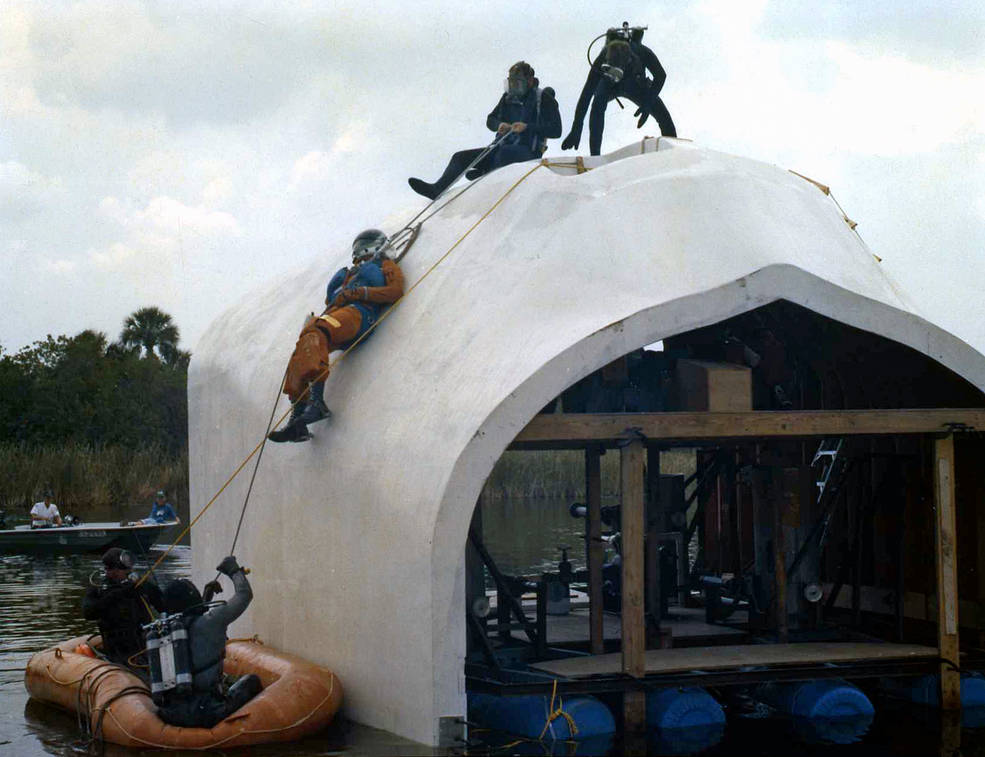In June 1980, much work still remained to prepare Space Shuttle Columbia for its first flight to usher in a new era of a reusable crewed space transportation system. Senior NASA managers believed March 1981 to be a realistic launch date for STS-1 as several key milestones were completed including the recertification of the orbiter’s main engines. Work on strengthening and re-attaching the orbiter’s thermal protection system tiles still remained the major pacing item for meeting the projected launch date. The prime crew for STS-1, John W. Young and Robert L. Crippen along with their backups Joe H. Engle and Richard H. Truly, continued to train for the mission and participated in some phases of the test activities.


Left: Flight certification test firing of a SSME at NSTL.
Right: Engineers re-installing SSMEs on Columbia in KSC’s OPF.
Engineers in Kennedy Space Center’s (KSC) Orbiter Processing Facility (OPF) removed the three Space Shuttle Main Engines (SSMEs) from Space Shuttle Columbia in May 1980 and shipped them to NASA’s National Space Transportation Laboratory (NSTL), now the Stennis Space Center in Bay St. Louis, Mississippi, for recertification. The three engines had passed acceptance tests between May and July 1979 and engineers first installed them in Columbia later that year, but managers requested the second round of tests following a number of modifications made to the engines, such as high pressure turbopumps, valves and nozzles. Full duration 520-second tests at NSTL on June 2, 5 and 16, recertified each engine for flight. The tests began with the engines at 100% thrust, then throttled down to 65% before returning to full thrust, a profile each engine would see during an actual flight. After the engines returned to KSC, engineers in the OPF installed them back on Columbia in July. Also at NSTL, engineers carried out a 9-minute 17-second test firing of the 3-engine Main Propulsion Test Article, the ninth such successful test. Engineers aborted a tenth test on July 12 after 105 seconds when data indicated a fire. Up to that time, the engines had completed the throttle-down and throttle-up steps and had even run up to 102% of rated thrust for 45 seconds, the first time a clustered engine firing had operated at that thrust level. Damage from the fire was limited to just one of the three engines.


Left: View of the flight deck of Space Shuttle Columbia.
Right: A technician re-installing thermal protection system tiles on Columbia.
Engineers in the OPF successfully completed an Orbiter Integrated Test (OIT) between July 7 and 14. The OIT included participation by the prime and backup crews and served to demonstrate the interaction of various orbiter systems with the vehicle’s computers and avionics as well as ground support systems. Systems tested included the Orbital Maneuvering System, the engines used to change the Shuttle’s orbit including the burn for reentry, and the Reaction Control System used to control the spacecraft’s attitude. The astronaut crews participated in simulations of the launch and reentry portions of the flight. Also in the OPF, technicians continued to install thermal protection system tiles on Columbia.


Left: Workers practice a Shuttle water rescue. Right: Wildlife officers corralling
Fat Albert, a Florida alligator that got too close to the test.
As readers may know KSC shares its territory with the Merritt Island National Wildlife Refuge, home to many species of animals native to Florida. Occasionally, the wildlife and space activities come into uncomfortably close contact. Such was the case in June 1980, when workers set up a mockup of the Space Shuttle forward fuselage to conduct escape trials in case an orbiter had to make an emergency water landing. A Florida alligator whom KSC employees had nicknamed “Fat Albert” lumbered out of the water to sun himself about 10 feet from the mockup. Workers halted the test and called in wildlife officers who corralled the 1,000-pound, 13-foot-9-inch alligator and transported him safely to a tourist attraction for protection. Workers then resumed the water evacuation drill, using weighted dummies as stand-ins for astronauts, lowering them from the top of the crew compartment to simulate an escape through the overhead hatch to divers waiting in the water.


Left: Group photograph of the Astronaut Class of 1980 – front row (left to right)
Bolden, Chang- Díaz, Cleave, Leestma, Spring, Richards, Bridges; middle row
(left to right) Bagian, Blaha, Nicollier, Hilmers, Fisher, Dunbar, Ross; back row
(left to right) Gardner, Springer, O’Connor, Ockels, Smith, Grabe; Lounge was not
present for the photograph. Right: Patch of the Astronaut Class of 1980.
On May 29, 1980, NASA announced the selection of 21 new astronaut candidates for the Class of 1980. Eight were chosen as Pilots – John E. Blaha, Charles F. Bolden, Roy D. Bridges, Guy S. Gardner, Ronald J. Grabe, Bryan D. O’Connor, Richard N. Richards and Michael J. Smith – and 13 as Mission Specialists – James P. Bagian, Franklin R. Chang-Díaz, Mary L. Cleave, Bonnie J. Dunbar, William F. Fisher, David C. Hilmers, David C. Leestma, John M. “Mike” Lounge, Claude Nicollier, Wubbo J. Ockels, Jerry L. Ross, Sherwood C. Spring and Robert C. Springer. For the first time NASA selected two candidates (Nicollier and Ockels) from the European Space Agency in addition to the nineteen from the United States. They reported to the Johnson Space Center in Houston on July 9 to begin a one-year training and evaluation period, following which they became eligible for assignment to Space Shuttle flight crews. As a group, the Class of 1980 distinguished itself with its members making a cumulative 65 space flights, including two who completed a record seven missions each (Ross and Chang- Díaz). Six (Chang- Díaz, Fisher, Leestma, Nicollier, Ross and Spring) completed a total of 18 spacewalks. The first to make a flight (Leestma) flew in October 1984 and the last flight by a member of the class (Chang- Díaz) took place in June 2002. Four (Blaha, Chang- Díaz, Dunbar and Ross) made flights to space stations as part Shuttle crews and one (Blaha) completed a long-duration mission aboard Mir. Two (Bolden and O’Connor) went on to hold high-level management positions at NASA Headquarters including one as Administrator (Bolden). One perished in the Challenger accident (Smith).
To be continued…
Significant world events in June 1980:
June 1 – First transmission of CNN (Cable News Network)
June 9 – Philadelphia Phillies and San Francisco Giants end their game at 3:11 AM (5-hour rain delay)
June 13 – United Nations Security Council calls on South Africa to release Nelson Mandela
June 16 – Film Blues Brothers starring Dan Aykroyd and John Belushi premieres in Chicago
June 23 – David Letterman Show debuts on NBC-TV daytime
June 27 – First female state police graduates (in New Jersey)


























